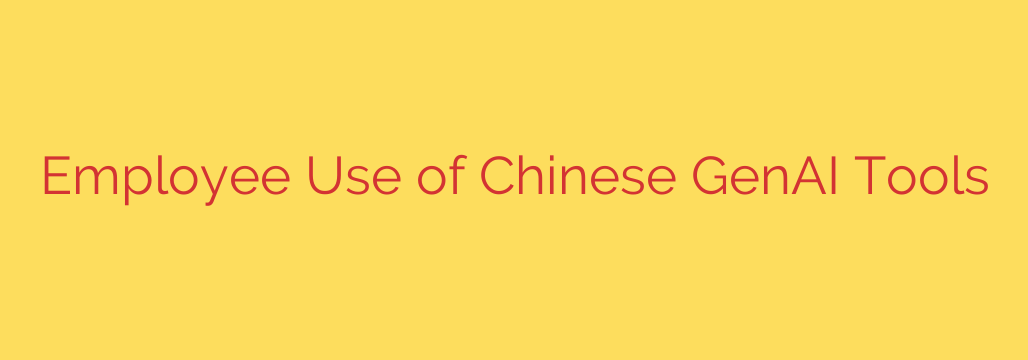
Unsanctioned AI in the Workplace: The Growing Security Risks of Chinese GenAI Tools
Generative AI has exploded into the mainstream, promising unprecedented gains in productivity and innovation. Employees across industries are enthusiastically adopting these tools to draft emails, write code, and brainstorm ideas faster than ever before. But this rush to embrace AI has a dark side: a growing and often invisible security threat known as “Shadow AI.”
When employees use unvetted AI tools, especially those developed in jurisdictions with different data privacy laws, they can unknowingly expose sensitive company data to significant risk. This issue becomes particularly acute when considering the use of generative AI platforms based in China, where data security and government oversight operate under a completely different framework than in the West.
The Hidden Data Leaks in Your AI Prompts
The core function of a generative AI tool is to process user input—the “prompt”—and generate a response. The problem is what happens to that prompt data afterward. Many free, publicly available AI models use this input to train their systems.
This means that every piece of information an employee enters into an unapproved AI tool could become part of its training data. This data might include:
- Proprietary source code
- Confidential client information
- Internal financial data
- Strategic business plans and marketing roadmaps
- Sensitive employee details
Once this information is absorbed by the model, it is effectively out of your company’s control. It could potentially be surfaced in response to another user’s query or be accessible to the AI provider’s employees. In essence, your company’s most valuable secrets are being fed directly into a black box with no guarantee of confidentiality.
Why the Origin of the AI Tool Matters
Not all AI tools are created equal, and their country of origin has serious implications for data security. Chinese national security laws, for example, can compel technology companies operating within their borders to share data with the government upon request.
This legal landscape creates a fundamental conflict with the data privacy expectations of most businesses. The legal and regulatory environment where an AI tool is based directly impacts the security and sovereignty of your data. Using an AI platform subject to these laws means that your corporate intellectual property could be exposed not just to the technology company but also to state actors, creating a significant risk of economic espionage and IP theft.
This isn’t just a theoretical concern. It’s a practical risk-management issue that every business leader must address. Ignoring the geopolitical context of the technology your teams are using is a critical oversight.
Protecting Your Business: A Proactive AI Security Strategy
The answer isn’t to ban AI entirely. The productivity benefits are too significant to ignore. Instead, businesses need to move from a reactive stance to a proactive one by implementing a clear and robust AI governance framework.
Here are actionable steps you can take to mitigate these risks:
Develop a Clear AI Acceptable Use Policy (AUP). Your organization needs official guidelines that explicitly state which AI tools are approved for use and what types of information are strictly forbidden from being entered into any AI platform. This policy should be clear, easy to understand, and communicated to all employees.
Educate and Train Your Team. Don’t just create rules; explain the reasoning behind them. Host training sessions that highlight the specific risks of data exposure, IP theft, and the legal implications of using unvetted tools. An informed workforce is your first and best line of defense.
Vet and Sanction Specific AI Tools. Rather than leaving employees to find their own solutions, your IT and security teams should evaluate and approve a set of secure, enterprise-grade AI tools. By providing a safe and powerful alternative, you reduce the temptation for employees to turn to riskier public platforms. Look for solutions that offer enterprise-level data privacy, zero data retention for training purposes, and clear contractual protections.
Implement Technical Controls. Use Data Loss Prevention (DLP) software and network monitoring to identify and block traffic to unauthorized AI websites. This creates a technical safety net that enforces your policy and provides visibility into potential “Shadow AI” usage.
Foster a Culture of Security. Encourage employees to think critically about the tools they use. Create an environment where they feel comfortable asking the security team for guidance before trying a new application. Security should be seen as a shared responsibility, not just an IT department function.
Generative AI is a transformative technology, but like any powerful tool, it must be handled with care and foresight. By understanding the risks and implementing a strong governance framework, your business can harness the power of AI for innovation while protecting its most valuable asset: its data. The time to build your AI security framework is now—before a preventable data leak becomes an irreversible crisis.
Source: https://www.helpnetsecurity.com/2025/07/21/chinese-genai-workplace-usage/








